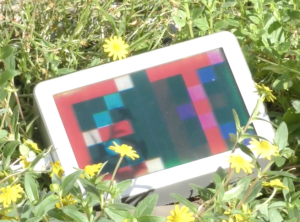Performance of reflective color displays in Out Of Home applications
At the IMID conference, Busan, August 28-31 2018, in South Korea, Etulipa spoke about the excellent performance of reflective color displays, based on the Electro Wetting Display technology.
Huge need for digital outdoor displays
Organizations communicate instantaneously in time with their targeted audience using social media and other internet platforms. Markedly, outdoor advertisement is in majority still done by paper-type signs which share the same messages for several weeks. Hence, there is a huge need for outdoor digital platforms that can be used by companies and other organizations to communicate with the outdoor audience in a timely manner. Commonly, LED screens are used for digital out-of-home displays. However, these use high amounts of energy because the brightness of the emitted light has to match that of daylight. In low daylight conditions, these screens cause significant light pollution. This is often contrary to local sign codes. These aspects prohibit widespread installments.
Are reflective displays an alternative for LED displays?
Reflective displays, that can be digitally controlled to update information instantaneously, are the ideal alternative for out-of-home displays because of their excellent readability in bright daylight, absence of intrusive light emission and very low energy consumption.
Just like LED displays, reflective displays have to meet the requirements of the client. Out-of-home reflective displays need excellent contrast and color performance, high switching speed for video applications, and have to operate in and withstand outdoor conditions for periods of typically 7 to 10 years.
These items are further discussed below.
What about the performance of reflective color displays?
The human perception of a reflective display is identical to that of any other object that reflects light. Therefore the Munsell color system is an excellent basis to evaluate reflective display performance. The parameters to create bright displays are:
a) lightness, relating to the possible white and black levels, and thus to the maximum contrast
b) the color possibilities (or hues) that can be realized
c) the realization of saturated color levels.
CMY color system versus RGB color system
In Etulipa’s whitepaper, (title: Electowetting displays Allow billboards anywhere!) it is explained that a bright reflective display needs a CMY subtractive color system. Reason is that the alternative, an RGB approach, will reflect maximally 1/3 of the possible light.
Fig 1: Comparing Intensity of reflected light from surfaces with CMY and RGC color filters.
In fig.1 an example is shown in which red light is reflected from a simplified RGB based display, and from a CMY stacked electro-wetting display. In the CMY approach the full area reflects incoming light, whereas in the RGB case 1/3 of the area reflects incoming light. The RGB approach will yield non-saturated colors.
The video still in fig. 2 demonstrates the saturated colors and high contrast of Etulipa’s electro-wetting displays using the CMY approach. These products have switching speeds complying with standard video requirements. You can watch switching speed in the video here.
Electro Wetting Display technology passes the tests
Etulipa has tested electro-wetting display modules for suitability for outdoor applications. The Mil. Std. 810G* is followed as guideline for evaluating the performance. Critical performance tests involve a) performance and compliance with temperatures from –40 oC up to +70 oC ; b) solar testing, to demonstrate stable quality in sunlight conditions; and c) vibration tests to test endurance of the products in transport and in outdoor conditions, where the displays are exposed to vibrations like wind and passing traffic.
*Mil. Std. 810G, Department of Defense Test Method Standard, Environmental Engineering Considerations and Laboratory Tests, 31 Oct 2008.
Download the Whitepaper: Electrowetting displays. Allow billboards anywhere!
Related posts
Blog: Etulipa presents full color demo with high quality saturated colors
Etulipa presents full color demo with high quality saturated colors Emissive displays vs reflective displays Especially in the summer period….
The first full-color Electro Wetting display panel is a fact
The first full-color Electro Wetting display panel is a fact Dedication, endurance and expertise in Electro Wetting. Those are the….
Etulipa’s Wall scaping displays at World Expo Dubai
Etulipa at the World Expo 2021 Dubai – UN World Cities Day Etulipa participates in the trade mission organized by….
Want to be kept up to date?
Subscribe to our newsletter and we will keep you updated on news and developments.


